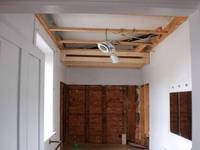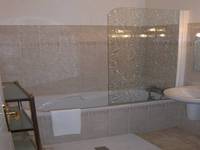Installing a leak-proof tile tub surround
I am installing ceramic tile in my bathroom shower, I have removed everything to the studs, what should I install before the tile?
-Tim Y. Flat Rock
Updating your bathroom is one of the best ways to increase the value of your home, not to mention increase your living experience. Designed and installed correctly, you can protect your home from mold growth and moisture damage.
As in most home improvement projects, preparation is the key. There are many underlayment products in the market and educating yourself can save you money and time.

Preparing for bathroom tile
Photo by soxophone players
The most commonly used cement boards are known as DUROCK and HardieBacker cement board, which is impervious to water. Installation can be slightly more challenging because they require special fasteners and cutting blades, but the benefits far out way the cost of the extra tools.

Beautiful!
Photo by Joe Shlabotnik
Before installing the board, attach a waterproof membrane over the studs and under the board. This will protect the wood in case of water penetration. If the water were to seep through the tile and cement board, it would run down the membrane, keeping the wood dry and free from water damage and mold. Don’t forget to create a seamless area after installing the cement board by taping all seams with joint tape.
Making your bathtub a masterpiece will take a little time and special attention, but the years of enjoyment of your “Work of Art” can be priceless.
Paul is a State of Michigan Licensed Builder. He serves as president and founding member of HandyPro Handyman Service and nationally franchised HandyPro International. Listen to Paul every Saturday at 11:00am on "It's Your Home, Let's Talk About It" WAAM Talk 1600AM. E-mail questions or comments to kpaul@handypro.com.


Comments
Keith A. Paul
Thu, Jun 24, 2010 : 1:36 p.m.
Mr. Morgan - As promised, Eric Williamson - Educational Trainer From Kerdi-Schluter will explain the process that you've requested on live air this Saturday at 11:35am 1600AM, I hope it's not too late. Thanks again for submitting your questions with annarbor.com.
Keith A. Paul
Wed, Apr 21, 2010 : 8:45 a.m.
Youre welcome and glad to help. According to the manufactures website, their product is waterproof and a vapor barrier. Since I have not used this product, I called the manufacture and spoke with Jennifer at Schluter-KERDI and she verified that all you need between the drywall/cement board and the mortar bed is the Kerdi membrane. They also wanted to emphasize the importance of using unmodified thin set mortar as opposed to Latex-modified mortar. They have been requested to explain the process on our live home improvement radio show. If they accept, I will post another comment with date and time for your convenience.
Bob Morgan
Mon, Apr 19, 2010 : 8:31 p.m.
After reading your reply and re-reading what I wrote I realize I did not say that I was going to put up tile instead of putting up tub surround again. Does that make a difference in how I should prepare the walls? I was planning on using the Kerdi waterproofing that is orange in colour; I understand there may be many Kerdi products on the market, but this is the only kind I have ever seen in Canada. Thanks in advance,
Keith A. Paul
Mon, Apr 19, 2010 : 10:56 a.m.
There are several Kerdi products on the market, including a shower system and waterproofing material. If youre installing Kerdi shower system, the manufacture claims that the vapor barrier is so tight that you could you standard drywall. However using standard drywall in a moisture area is asking for trouble. When installed correctly, most tub surrounds can be installed with green board and is the product I would use in this case. It maybe excess, but you will be extra safe using cement board. You can bring the material to about an 1/8 inch over the tub lip and allow for expansion and contraction. Enjoy.
Bob Morgan
Sun, Apr 18, 2010 : 5:39 p.m.
I too am working on my bathroom and have taken it all back to the vapour barrier. There used to be plastic tub surround and I want to use cement board with Kerdi to make a moisture proof barrier. With using the Kerdi, will that be enought for moisture proofing? Also, when I am installing the Kerdi, how far down into the tub should it be installed - just over the lip/nailing strip of the tub? This is the first time I have ever done this and am beyond confused!!!